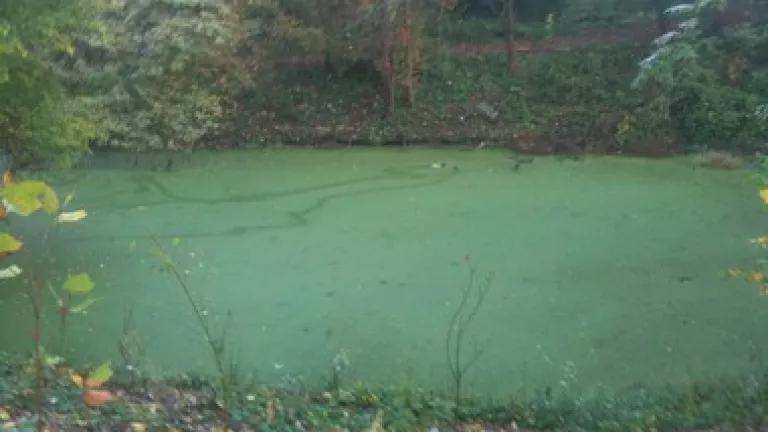
One of the things I like best about working at NRDC is that I can call things as I see them, even when that means confronting people and institutions that we often trust and support. For instance, in a pair of legal actions we've just filed with several partner groups, most of which are based in the Mississippi River basin, we’re not pulling any punches with the Environmental Protection Agency – we’re telling them straight that the agency has fallen down on its job of protecting Americans’ water from a major pollution problem.
Nitrogen and phosphorus pollution is pernicious. As EPA itself says, “[n]utrient pollution is one of America's most widespread, costly and challenging environmental problems. . . .” For starters, algae feed on these nutrients and grow like crazy, often covering water bodies in slime, as pictured here (a small pond in Arlington, Virginia). Algae then die and decompose, robbing the water of dissolved oxygen in the process. In addition, algae can produce nasty toxins that are harmful to humans and animals. And, a form of nitrogen in drinking water can lead to extreme health problems in infants.
One of the biggest – literally – problems caused by nitrogen and phosphorus pollution is the “Dead Zone” that forms in the Gulf of Mexico. Pollution flows down the Mississippi River, nourishing algae blooms in the Gulf, and when those algae die off, the resulting processes cause an area of the Gulf's bottom layer of water to become so oxygen-deprived (or "hypoxic") that fish and many other aquatic organisms either flee or die. In recent decades, the average size of the "Dead Zone" has reached state-sized proportions. Last summer, it covered 6,765 square miles (a down year, actually, probably owing to a tropical storm that occurred during the measurement effort), which makes it about six and a half times the size of Rhode Island.
There have been numerous reports about the seriousness of nitrogen and phosphorus (which EPA typically calls “nutrient pollution,” but which I prefer to call Dead Zone pollution) and the need to address it – including one called “An Urgent Call to Action,” written by state and federal water pollution control experts. Notwithstanding extensive study and notwithstanding years of EPA essentially begging states to step up their own controls, EPA has failed to use its significant authority under the Clean Water Act to adequately control sources of Dead Zone pollution, like industrial livestock operations, wastewater treatment plants, agribusiness, and urban and suburban runoff.
And that’s why we had to go to court. As I wrote several years ago, a bunch of citizen groups petitioned EPA to establish numeric limits on the amount of nitrogen and phosphorus allowable in the nation’s waterways where states had failed to do so. After a long delay, EPA denied this petition earlier this last year, taking a curious approach – the agency acknowledged that this pollution “presents a significant water quality problem facing our nation,” but said that taking federal action was “not a practical or efficient way to address nutrients at a national or regional scale.” We’re challenging this denial in court because EPA’s response dodges the fundamental question it needs to answer, and is nonsensical in light of the history of inaction on the issue.
We’re also suing the agency because it has simply refused to respond to a separate petition many of our groups filed back in 2007, asking EPA to update the national pollution control standards applicable to publicly-owned treatment works and include limits for nitrogen and phosphorus. These facilities are important contributors of nitrogen and phosphorus, yet they are not adequately controlled. By going to court, we’re demanding only that the agency actually evaluate our claims and rule on them. Given the seriousness of this issue nationally, that hardly seems like a lot to ask.
Together, these actions will force EPA to acknowledge and – we hope – exercise its responsibilities under the Clean Water Act to reduce a critical and pressing pollution problem.
Correction: An earlier version of this post incorrectly stated when EPA denied the petition concerning the amount of Dead Zone pollution allowed in U.S. water bodies.

